Description: War Thunder is a next generation military MMO game dedicated to...

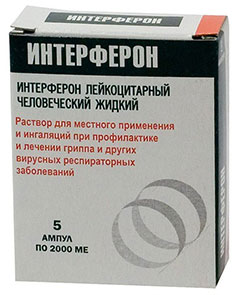
Human leukocyte interferon is an immunomodulatory drug with antiviral, antitumor and antiproliferative effects.
Dosage forms of Interferon:
The active substance of the drug is interferon alfa.
Parenterally Interferon human leukocyte is prescribed for:
Rectally Interferon is used in acute and chronic viral hepatitis.
Intranasal and inhalation drug is prescribed for the prevention and treatment of acute respiratory viral infections and influenza.
Human leukocyte interferon is contraindicated in:
During pregnancy, the drug can be used only if the benefit to the woman outweighs the possible risks to the fetus.
If necessary, treatment during lactation breast-feeding should be stopped.
Special observation during the period of Interferon use is necessary for the elderly, patients with a history of myocardial infarction, as well as for myelodepression and changes in blood clotting.
With caution, the drug is used simultaneously with opioid analgesics, sedatives and hypnotics.
Doses and duration of treatment, especially with parenteral administration, are set by the doctor individually for each patient, taking into account the indications, the severity of the course of the disease, the method of application and the reaction of the body.
Average daily doses for i / m administration, depending on the indications:
In acute and chronic viral hepatitis, as a rule, 1 suppository per day is prescribed. The course of treatment is 10 days.
For influenza and SARS, a solution is prepared from the lyophilisate using distilled or boiled water at room temperature: it is poured directly into the ampoule to the mark corresponding to 2 ml, then shaken well until the powder is completely dissolved. The contents of the ampoule with the finished solution is also diluted with 2 ml of water.
For the prevention of influenza and SARS, it is recommended to start using Interferon when there is a threat of infection and continue therapy until the risk of infection persists. The drug is instilled into each nasal passage 5 drops (or sprayed 0.25 ml) twice a day with a minimum interval of 6 hours.
With a therapeutic purpose, human leukocyte interferon should be used when the first signs of a "cold" appear. The solution is instilled 5 drops into each nasal passage at least 5 times a day at intervals of 1-2 hours for 2-3 days.
Another effective method application - inhalation (through the mouth or nose). For one inhalation, the contents of 3 ampoules are dissolved in 10 ml of water, slightly warmed up (to a maximum temperature of 37 ºС), procedures are carried out 2 times a day.
Possible side effects of human leukocyte Interferon:
Most often, adverse reactions are observed with parenteral use.
The earlier the use of Interferon for influenza and SARS, the higher the effectiveness of the drug.
If the number of platelets in thrombocytopenia is less than 50 thousand / μl, the drug is administered subcutaneously.
With the development of side effects from the central nervous system in elderly people receiving high doses of interferon alfa, an additional examination is carried out. In some cases, treatment has to be interrupted.
During the period of use of the drug, it is necessary to ensure sufficient fluid intake into the body, especially at the beginning of treatment, to control liver function and the content of blood cells. Patients of childbearing age are advised to use reliable methods of contraception.
Before treating hepatitis C, the level of TSH in the blood serum should be determined, Interferon can be prescribed only in the case of a normal indicator.
In case of flu-like symptoms, paracetamol is prescribed.
Interferons inhibit oxidative metabolism in the liver, therefore, the biotransformation of drugs metabolized in this way may be impaired.
With the simultaneous use of the drug with zidovudine, synergism is possible with respect to myelotoxic action, with ACE inhibitors - synergism of hematotoxic action, with theophylline - a decrease in its clearance, with paracetamol - an increase in liver enzymes.
Alfaferon, Wellferon, Interferon alfa-2b human recombinant, Interferon alfa-2 recombinant hydrogel-based ointment, Inferon, Lokferon.
Store at 2-10 ºC. Keep away from children!
Shelf life - 2 years. The solution prepared from the lyophilisate can be stored for no more than 2 days in the refrigerator.
Modern medicine for the complex treatment of diseases, prevention of various ailments, uses special immunomodulatory drugs, among which human Interferon stands out.
Human interferon is a low molecular weight protein that has pronounced antiviral and powerful immunomodulatory properties, as well as high antitumor activity.
Interferon was first discovered in 1957, when scientists discovered that this substance actively prevents the reproduction of influenza viruses that have fallen into human body. Further studies have found that not only viruses are capable of causing the body to produce interferons, various other microorganisms and some synthetic substances, later called interferon inducers, have this effect.
There are several types of interferons produced in the body by special tissue cells or created synthetically. Interferon Alpha is produced by peripheral blood β-lymphocytes, and fibroblasts produce β-interferon.
T-lymphocytes take an active part in the production of this low molecular weight protein, which not only protect the body from various viral infections, but also from viruses of a tumor nature. The use of Interferon is effective for the treatment of a number of skin diseases that are caused by pathogenic viruses.
In some viral infections, the interferon reaction of leukocytes serves as an indicator of the body's immunoreactivity.
Interferon human dry is available in the form of a powder or rectal suppositories. One 2 ml ampoule contains lyophilized powder, 1000 IU of antiviral activity.
Interferon Alpha (human) is a mixture of different subtypes of natural interferon from human blood leukocytes. The antiviral effect of Interferon Alpha is mainly based on an increase in the resistance of non-virus-infected cells to possible effects. On the cell surface, Interferon Alpha binds to specific receptors and changes the properties of cell membranes, stimulates enzymes, actively affects the RNA of the virus, effectively preventing its replication.
The immunomodulatory property of the substance is based on stimulating the activity of macrophages and NK cells involved in the body's immune response to specific tumor cells.
The use of Interferon suppresses chlamydia and viruses, normalizes the body's immune status, and inhibits the growth of tumor cells.
The substance is indicated for use in such diseases:
Interferon is prescribed rectally for the complex treatment of secondary immunodeficiency states, hemorrhagic fever with renal syndrome. Interferon for children 2-12 years old is also prescribed in the form of rectal suppositories in the treatment of acute hepatitis B.
In viral eye diseases - conjunctivitis, keratitis and keratouveitis, the drug is prescribed as an instillation into the conjunctival sac.
 A solution of the drug for intranasal use or instillation into the conjunctival sac is prepared as follows: 1 ampoule with dry lyophilized powder is diluted with 2 ml of distilled or boiled water. The red solution can be stored in the refrigerator for no more than two days.
A solution of the drug for intranasal use or instillation into the conjunctival sac is prepared as follows: 1 ampoule with dry lyophilized powder is diluted with 2 ml of distilled or boiled water. The red solution can be stored in the refrigerator for no more than two days.
Human interferon for the prevention of acute respiratory viral infections and influenza is used intranasally, 5 drops in each nostril twice a day with a break of six hours. The drug should be used at the first clinical manifestations illness. For the treatment of these diseases, 5 drops of the drug are instilled into each nostril with an interval of 1-2 hours 5-6 times / day for two to three days.
Also use inhalation with the drug in the nose or mouth. For one inhalation, the contents of three ampoules are used, which are diluted in 10 ml of water heated to 37 ° C. Inhalation is carried out twice a day with a break of 1-2 hours.
Interferon for children is used as an effective prophylactic during outbreaks of SARS and influenza.
The frequency, dosage and duration of the use of Interferon in other diseases, the specialist sets individually, depending on the patient's response, the severity of the disease, the indications and the route of administration of the drug.
The instructions for Interferon give the following dosages:
The use of Interferon can lead to side effects such as headache and muscle pain, lethargy, fever, dry mouth, sweating, diarrhea, loss of appetite, vomiting, constipation, flatulence, nausea, heartburn and hepatitis.
The drug can also cause visual disturbances, liver failure, sleep disturbances, depression, dizziness, increased peristalsis, ischemic retinopathy, nervousness, joint pain. The occurrence of allergic reactions is noted - itching, skin rash, hyperemia.
Interferon and Interferon Alfa should not be given to people with hypersensitivity and autoimmune diseases. You can not use the drug for myocardial infarction, CHF, diabetes mellitus, accompanied by ketoacidosis, with cirrhosis of the liver, severe mental disorders, epilepsy and dysfunction of the central nervous system.
It is forbidden to prescribe the substance to people with thyroid diseases, with severe disorders in the liver and kidneys. Interferon is prescribed with extreme caution for children under 2 years of age, pregnant and lactating women and patients who have taken immunosuppressants.
Attention!
The description of the drug posted on this page is a simplified version of the official version of the annotation for the drug. The information is provided for informational purposes only and is not a guide for self-treatment. Before using the drug, you should consult with a specialist and read the instructions approved by the manufacturer.
3.68 3.68 out of 5 (37 Votes)
Dry freeze-dried powder
Interferon human leukocyte dry contains:
1 ampoule of dry freeze-dried powder contains:
Active substance: human leukocyte interferon 1000 IU.
Human leukocyte interferon is a mixture of various subtypes of natural interferon alpha from human blood leukocytes. It has antiviral, antiproliferative, immunomodulatory and antitumor effects. The mechanism of antiviral action is to create protective mechanisms in cells that are not infected with the virus: changing the properties of cell membranes that prevent the penetration of the virus into the cell, initiating the synthesis of a number of specific enzymes that prevent the replication of viral RNA and the synthesis of viral proteins. The antiproliferative effect is due to direct mechanisms that cause changes in the cytoskeleton and cell membrane, which regulate the processes of differentiation and cellular metabolism, which in turn prevent cell proliferation, especially tumor cells. It helps to modulate the expression of some oncogenes (myc, sys, ras), which makes it possible to "normalize" neoplastic transformation of cells and thereby inhibit tumor growth. The immunomodulatory effect is due to the stimulation of the activity of macrophages and natural killer cells (macrophages are involved in the process of antigen presentation to immunocompetent cells, and natural killer cells are involved in the body's immune response to tumor cells).
Hairy cell leukemia, chronic myeloid leukemia, viral hepatitis B, viral active hepatitis C, primary (essential) and secondary thrombocytosis, transitional form of chronic granulocytic leukemia and myelofibrosis, multiple myeloma, kidney cancer, AIDS-related Kaposi's sarcoma, mycosis fungoides, reticulosarcoma, multiple sclerosis, prevention and treatment of influenza and acute respiratory viral infection.
The use of interferon alfa preparations during pregnancy is possible only in cases where the intended benefit to the mother outweighs the potential risk to the fetus. If necessary, use in a nursing mother during lactation should decide on the termination of breastfeeding.
Patients of reproductive age during therapy should use reliable methods of contraception.
The dose, frequency and duration of use are set depending on the indications, the severity of the disease, the route of administration, and the individual response of the patient.
Lethargy, fever, chills, loss of appetite, muscle pain, headache, joint pain, sweating, nausea, vomiting, change in taste, dry mouth, weight loss, diarrhea, abdominal pain, constipation, flatulence, increased peristalsis, heartburn, liver dysfunction, hepatitis, dizziness, visual disturbances, ischemic retinopathy, depression, drowsiness, impaired consciousness, nervousness, sleep disturbance, skin allergic reactions (rash, itching).
Interferon solution should be prepared immediately before use. In the course of treatment with Interferon human leukocyte dry, systematic monitoring of the blood and liver picture is necessary. If flu symptoms occur, take paracetamol.
Not described.
Not described.
Store at a temperature of 2 to 10C°.
Among foreign and Russian analogues of interferon leukocyte human dry, there are:
Kamistad. Producer: Shtada Artsnaymittel AG (Germany). Price in pharmacies from 269 rubles.
Grippferon. Producer: Firn M (Russia). Price in pharmacies from 260 rubles.
The composition of interferon preparations depends on their form of release.
Interferon preparations have the following release forms:
IFN preparations belong to the group of medicines antiviral and immunomodulatory action .
All IFNs have antiviral and antitumor activity . Equally important is their ability to stimulate action. macrophages - cells that play an important role in initiation.
IFNs contribute to an increase in the body's resistance to penetration viruses and block reproduction viruses when they enter the cell. The latter is due to the ability of IFN to suppress translation of the messenger (messenger) RNA of the virus .
At the same time, the antiviral effect of IFN is not directed against certain viruses , that is, IFNs are not characterized by virus specificity. This explains their versatility and wide range antiviral activity.
The main biological effect of α-IFN is inhibition of viral protein synthesis . The antiviral state of the cell develops within a few hours after the application of the drug or the induction of IFN production in the body.
However, IFN does not affect early stages replication cycle, that is, at the stage of adsorption, penetration virus into the cell (penetration) and release of the internal component virus in the process of undressing him.
Antivirus action α-IFN is manifested even in the case of cell infection infectious RNA . IFN does not enter the cell, but only interacts with specific receptors on cell membranes (gangliosides or similar structures containing oligosugar ).
The mechanism of activity of IFN alpha resembles the action of individual glycopeptide hormones . It stimulates activity genes , some of which are involved in coding the formation of products with direct antiviral action .
β interferons also have antiviral action , which is associated with several mechanisms of action at once. Beta interferon activates NO-synthetase, which in turn increases the concentration of nitric oxide inside the cell. The latter plays a key role in the suppression of reproduction viruses .
β-IFN activates secondary, effector functions natural killerosin , B-type lymphocytes , blood monocytes , tissue macrophages (mononuclear phagocytes) and neutrophilic , which are characterized by antibody-dependent and antibody-independent cytotoxicity.
In addition, β-IFN blocks the release of the internal component virus and disrupts methylation processes virus RNA .
γ-IFN is involved in the regulation of the immune response and regulates the severity inflammatory reactions. Although he has his own antiviral and antitumor effect , gamma interferon very weak. At the same time, it significantly enhances the activity of α- and β-IFN.
After parenteral administration, the maximum concentration of IFN in is observed after 3-12 hours. The bioavailability index is 100% (both after injection under the skin and after injection into the muscle).
The duration of the half-life T½ is from 2 to 7 hours. Trace concentrations of IFN in plasma are not detected after 16-24 hours.
IFN is designed to treat viral diseases that hit respiratory tract .
In addition, interferon preparations are prescribed to patients with chronic forms hepatitis, and Delta .
For treatment viral diseases and, in particular, IFN-α is predominantly used (both of which are IFN-alpha 2b and IFN-alpha 2a). The "gold standard" of treatment hepatitis C considered to be pegylated interferons alpha-2b and alpha-2a. In comparison with them, conventional interferons are less effective.
The genetic polymorphism noted in the IL28B gene, which is responsible for encoding IFN lambda-3, causes significant differences in the effect of treatment.
Patients with genotype 1 hepatitis C with common alleles of this gene are more likely to achieve longer and more pronounced treatment results compared to other patients.
IFN is also often given to patients with oncological diseases : malignant , pancreatic endocrine tumors , non-Hodgkin's lymphoma , carcinoid tumors ; Kaposi's sarcoma , due to ; hairy cell leukemia ,multiple myeloma , kidney cancer etc..
Interferon is not prescribed to patients with hypersensitivity to it, as well as to children and adolescents suffering from severe mental disorders and disorders nervous system , which are accompanied by thoughts of suicide and suicide attempts, severe and protracted.
In combination with antiviral drug Ribavirin IFN is contraindicated in patients diagnosed with severe impairment kidney (conditions in which CC is less than 50 ml / min).
Interferon preparations are contraindicated in case of (in cases where the appropriate therapy does not give the expected clinical effect).
Interferon belongs to the category of drugs that can cause a large number of adverse reactions from the side various systems and organs. In most cases, they are the result of the introduction of interferon in / in, s / c or / m, but other pharmaceutical forms of the drug can also provoke them.
The most common adverse reactions to taking IFN are:
Vomiting, increased, feeling of dry mouth, hair loss (), asthenia ; non-specific symptoms resembling flu symptoms ; backache, depressive states , musculoskeletal pain , thoughts of suicide and suicide attempt, general malaise, impaired taste and concentration, increased irritability, sleep disorders (often), arterial hypotension , confusion.
To the rare side effects include: pain on the right in the upper abdomen, rashes on the body (erythematous and maculopapular), increased nervousness, soreness and severe inflammation at the injection site, secondary viral infection (including infection herpes simplex virus ), increased dryness of the skin, , pain in the eyes , conjunctivitis blurred vision, dysfunction lacrimal glands , anxiety, mood lability; psychotic disorders , including increased aggression, etc.; hyperthermia , dyspeptic symptoms , respiratory disorders, weight loss, loose stools, hyper or hypothyroidism , hearing impairment (up to its complete loss), the formation of infiltrates in the lungs, increased appetite, bleeding gums, convulsions in the limbs dyspnea , renal dysfunction and development of renal failure , peripheral ischemia , hyperuricemia , neuropathy etc..
Treatment with IFN drugs can cause reproductive dysfunction . Studies in primates have shown that interferon violates menstrual cycle among women . In addition, in women treated with IFN-α, the level of and in.
For this reason, when prescribing interferon, women of childbearing age should use barrier contraceptives . Men of reproductive age are also advised to be informed of potential side effects.
In rare cases, treatment with interferon may be accompanied by ophthalmic disorders, which are expressed as hemorrhages in the retina , retinopathy (including but not limited to macular edema ), focal changes in the retina, decreased visual acuity and / or limited visual fields, papilledema , neuritis of the ophthalmic (second cranial) nerve , arterial obstruction or retinal veins .
Sometimes against the background of taking interferon can develop hyperglycemia , symptoms of nephrotic syndrome , . In patients with diabetes may worsen the clinical picture of the disease.
It cannot be ruled out that the possibility of cerebrovascular hemorrhage , erythema multiforme , tissue necrosis at the injection site cardiac and cerebrovascular ischemia , hypertriglyceridermia , sarcoidosis (or exacerbation of its course), Lyell's syndromes and Stevens-Johnson .
The use of interferon alone or in combination with Ribavirin in rare cases, it can cause aplastic anemia (AA) or even PAKKM ( complete aplasia of the red bone marrow ).
There were also cases when, on the background of treatment with interferon preparations, the patient developed various autoimmune and immune-mediated disorders (including Werlhof's disease and Moszkowitz's disease ).
Instructions for the use of interferons alpha, beta and gamma indicate that before prescribing a drug to a patient, it is recommended to determine how sensitive to it that caused the disease.
The method of administration of human leukocyte interferon is determined depending on the diagnosis made to the patient. In most cases, it is prescribed in the form of subcutaneous injections, but in some cases the drug can be injected into a muscle or vein.
The dose for treatment, the maintenance dose and the duration of treatment are determined depending on the clinical situation and the response of the patient's body to the therapy prescribed to him.
“Children's” interferon is suppositories, drops and ointment.
Instructions for the use of interferon for children recommends the use of this drug as a therapeutic and prophylactic agent. The dose for infants and older children is selected by the attending physician.
For prophylactic purposes, INF is used in the form of a solution, for the preparation of which distilled or boiled water at room temperature is used. The finished solution is colored red and opalescent. It should be stored in the cold for no more than 24-48 hours. The drug is instilled into the nose of children and adults.
At viral ophthalmic diseases the drug is prescribed in the form of drops for the eyes.
As soon as the severity of the symptoms of the disease decreases, the volume of instillations should be reduced to one drop. The course of treatment is from 7 to 10 days.
For the treatment of lesions caused by herpesviruses , the ointment is applied with a thin layer to the affected areas of the skin and mucous membranes twice a day, maintaining 12-hour intervals. The course of treatment is from 3 to 5 days (until the integrity of the damaged skin and mucous membranes is completely restored).
For prevention ORZ and must be lubricated nasal passages . The frequency of procedures during the 1st and 3rd week of the course is 2 times a day. During the 2nd week, it is recommended to take a break. For prophylactic purposes, interferon should be used throughout the entire period epidemics of respiratory diseases .
The duration of the rehabilitation course in children who often have recurrent viral and bacterial infections of the respiratory tract , ENT organs , recurrent infection caused by herpes simplex virus , is two months.
How to breed and how to use interferon in ampoules?
Instructions for the use of interferon in ampoules indicate that before use, the ampoule must be opened, poured into it with water (distilled or boiled) at room temperature up to the mark on the ampoule corresponding to 2 ml.
The contents are gently shaken until completely dissolved. The solution is injected into each nasal passage twice a day, five drops, maintaining intervals of at least six hours between injections.
For therapeutic purposes, IFN is started when the first flu symptoms . The effectiveness of the drug is higher, the sooner the patient starts taking it.
The most effective is the inhalation method (through the nose or mouth). For one inhalation, it is recommended to take the contents of three ampoules of the drug, dissolved in 10 ml of water.
Water is preheated to a temperature not exceeding +37 °C. Inhalation procedures are carried out twice a day, maintaining an interval of at least one to two hours between them.
When spraying or instillation, the contents of the ampoule are dissolved in two milliliters of water and injected 0.25 ml (or five drops) into each nasal passage three to six times a day. The duration of treatment is 2-3 days.
For preventive purposes, nose drops for children are instilled (5 drops) twice a day, at the initial stage of the development of the disease, the frequency of instillations is increased: the drug should be administered at least five to six times a day every hour or two.
Many are interested in whether it is possible to drip a solution of interferon into the eyes. The answer to this question is in the affirmative.
Cases of overdose with interferon are not described.
β-IFN is compatible with corticosteroid drugs and ACTH. Should not be taken during treatment myelosuppressive drugs , incl. cytostatics (this may cause additive effect ).
With caution, IFN-β is prescribed with agents whose clearance is largely dependent on cytochrome P450 systems (antiepileptic drugs , some antidepressants and etc.).
Do not take IFN-alpha and Telbivudine . The simultaneous use of α-IFN provokes a mutual enhancement of action in relation to. When used together with phosphazide can mutually increase myelotoxicity both drugs (it is recommended to carefully monitor changes in the amount granulocytes and level ).
A prescription is required to dispense the drug.
Interferon is stored in a cool, protected from sun rays place at a temperature of +2 to +8°C. List B.
24 months. The prepared solution of interferon at room temperature remains stable for 3 days.
Interferon - what is it?
Interferons are a class with similar properties glycoproteins , which are produced by vertebrate cells in response to exposure to various types of inducers, both viral and non-viral in nature.
According to Wikipedia, in order for a biologically active substance to be qualified as an interferon, it must be of a protein nature, have a pronounced antiviral activity in relation to various viruses , at least in homologous (similar) cells, "mediated by cellular metabolic processes, including RNA and protein synthesis."
The classification of IFNs proposed by the WHO and the Interferon Committee is based on differences in their antigenic, physical, chemical and biological properties. In addition, she takes into account species affiliation and cellular origin.
According to antigenicity (antigenic specificity), IFN is usually divided into acid-resistant and acid-labile. Alpha and beta interferons (also called type I IFNs) are acid-fast. Interferon gamma (γ-IFN) is acid-labile.
α-IFN produce peripheral blood leukocytes (B- and T-type leukocytes), so it was previously designated as leukocyte interferon . Currently, there are at least 14 of its varieties.
β-IFN is produced fibroblasts , so it is also called fibroblastic .
Former designation γ-IFN - immune interferon , but its stimulated T-type lymphocytes , NK cells (normal (natural) killers; from the English “natural killer”) and (presumably) macrophages .
Main properties and mechanism of action of IFN
Without exception, all IFNs are characterized by polyfunctional activity against target cells. Their most common property is the ability to induce in them antiviral state .
Interferon is used as a therapeutic and prophylactic agent for various viral infections . A feature of IFN preparations is that their effect weakens with repeated injections.
The mechanism of action of IFN is related to its ability to inhibit viral infections . As a result of treatment with interferon drugs in the patient's body around focus of infection a kind of barrier is formed from resistant to virus uninfected cells, which prevents further spread of the infection.
Interacting with still intact (intact) cells, it prevents the implementation of the reproductive cycle viruses by activating certain cellular enzymes ( protein kinases ).
The most important function of interferons is the ability to suppress hematopoiesis ; modulate the body's immune response and inflammatory response; regulate the processes of cell proliferation and differentiation; inhibit growth and prevent reproduction viral cells ; stimulate the expression of surface antigens ; suppress individual functions B- and T-type leukocytes to stimulate activity NK cells etc..
Use of IFN in biotechnology
Development of methods for synthesis and high-performance purification leukocyte and recombinant interferons in quantities sufficient for the production of drugs, made it possible to open the possibility of using IFN preparations for the treatment of patients diagnosed with viral hepatitis .
A distinctive feature of recombinant IFNs is that they are produced outside the human body.
For example, recombinant interferon beta-1a (IFN β-1a) is obtained from mammalian cells (in particular, from Chinese hamster ovary cells), and interferon beta-1b (IFN β-1b), similar in its properties, is produced by family mumps or );
IFN is also used in therapy, the purpose of which is the rehabilitation of frequently ill patients. respiratory infections children.
Most best option reception for children - drops in the nose: interferon with this use does not penetrate the gastrointestinal tract (before diluting the drug for the nose, the water should be heated to a temperature of 37 ° C).
For infants, interferon is prescribed in the form of suppositories (150 thousand IU). Candles for children should be administered one at a time, 2 times a day, maintaining 12-hour intervals between injections. The course of treatment is 5 days. To fully cure a child SARS As a rule, one course is enough.
For treatment, take 0.5 g of ointment twice a day. Treatment lasts an average of 2 weeks. Over the next 2-4 weeks, the ointment is applied 3 times a week.
Numerous positive reviews about the drug indicate that in this dosage form he has also established himself as effective remedy for treatment stomatitis and inflamed tonsils . No less effective are inhalations with interferon for children.
The effect of using the drug increases significantly if a nebulizer is used for its administration (it is necessary to use a device that sprays particles with a diameter of more than 5 microns). Inhalations through a nebulizer have their own specifics.
First, interferon must be inhaled through the nose. Secondly, before using the device, it is necessary to turn off the heating function in it (IFN is a protein, it is destroyed at a temperature of more than 37 ° C).
For inhalation in a nebulizer, the contents of one ampoule are diluted in 2-3 ml of distilled or mineral water(you can also use saline for this purpose). The resulting volume is enough for one procedure. The frequency of procedures during the day is from 2 to 4.
It is important to remember that long-term treatment of children with interferon is not recommended, since addiction develops to it and, therefore, the expected effect does not develop.
An exception may be cases where the expected benefit of therapy for the expectant mother will outweigh the risk of adverse reactions and adverse effects on fetal development.
The possibility of isolating components of recombinant IFN with breast milk. Due to the fact that the possibility of exposure to the fetus through milk cannot be excluded, IFN is not prescribed for lactating women.
In extreme cases, when it is impossible to avoid the appointment of IFN, it is recommended that a woman refuse to breastfeed during therapy. To soften side effect drug (the occurrence of symptoms similar to those of influenza), simultaneous administration with IFN is recommended .
Viral diseases lie in wait for the average person several times a year. You can deal with them in different ways. But, the quality of treatment and the speed of recovery depends on the effectiveness of the drugs used. One of the best drugs for viral diseases at the moment is Interferon.
It should be noted that human leukocyte Interferon is an excellent immunomodulatory, antiviral and antitumor drug. This tool helps the cells of the body organize additional protection against the virus.
IMPORTANT: Interferons are proteins that the body produces when a virus enters it. The medicinal product, which in question, helps to activate the body's process of producing protective proteins.
In 1957, virologists A. Isaac and D. Lindeman discovered an amazing defense mechanism that turns on in the cells of the body at the time of infection of one of them. This mechanism is "registered" at the genetic level. When one of the cells becomes infected with a virus, it produces special protein molecules (interferons). These molecules enter neighboring cells and make them immune to the virus.
Human leukocyte interferon is a protective protein that, when ingested, aids the immune system and fights diseased viruses.
The tool is available in the form:
"Interferon" is indicated in the treatment of influenza and SARS. He is able to help tick-borne encephalitis and hepatitis C and B. As part of complex treatment, this remedy is prescribed for leukemia, malignant and benign neoplasms.
Drops of this remedy are used to treat viral eye lesions: keratitis, keratouveitis and conjunctivitis.
Rectal suppositories of this drug are used in secondary immunodeficiency states.
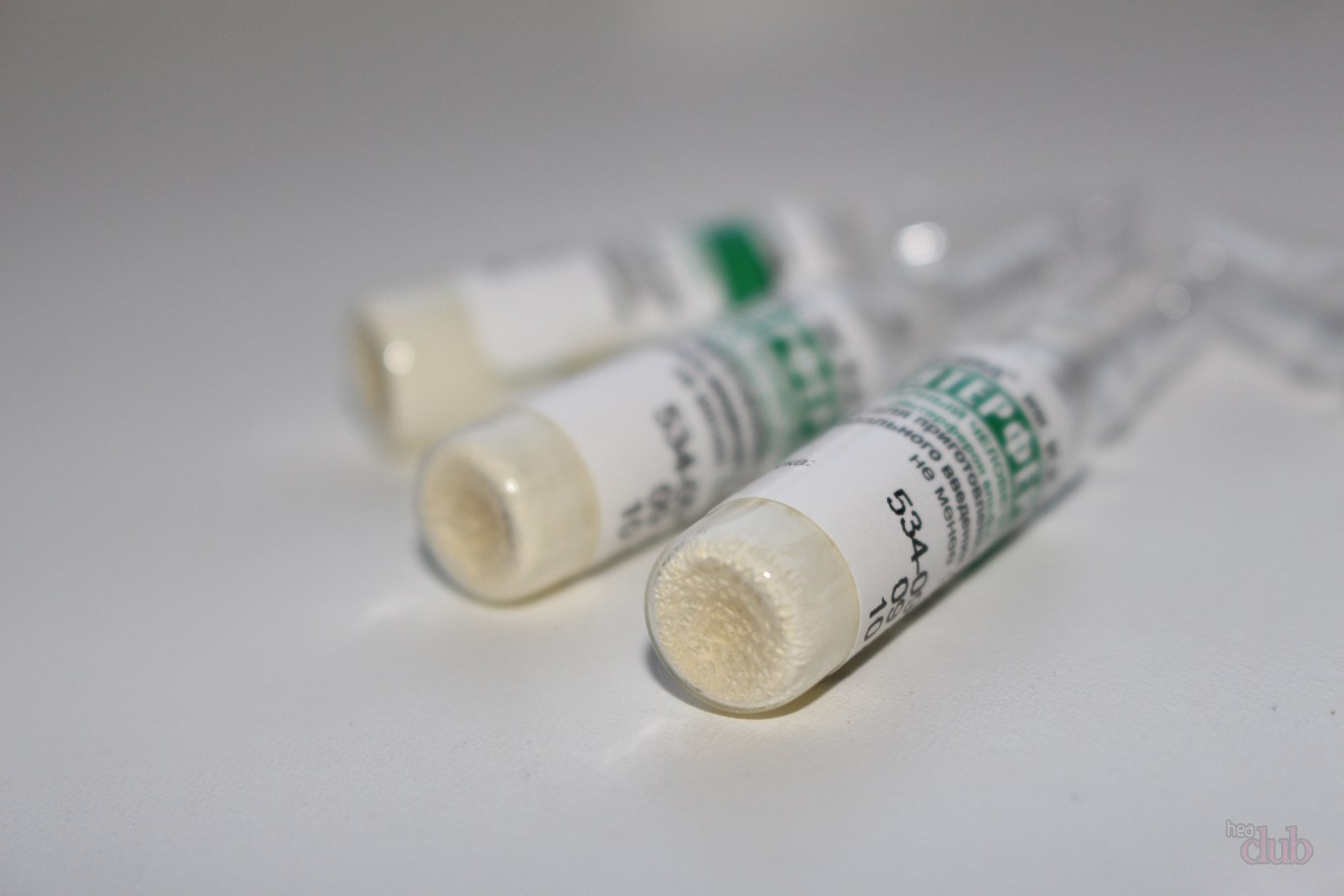
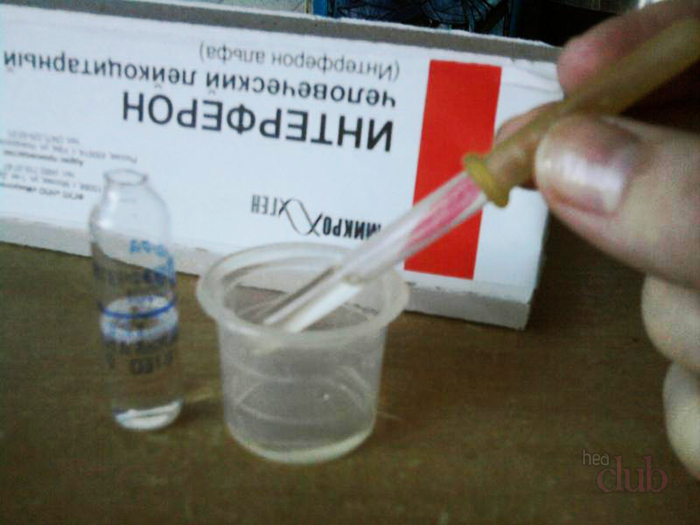
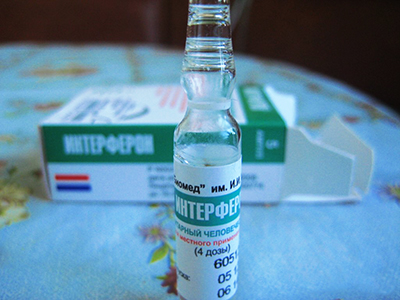
You can not use the drug for:
During pregnancy, this drug is prescribed with great caution. It can be used only if the risk of endangering the fetus is less than the benefit of this remedy for the woman. You can use "Interferon" only from the twenty-eighth week of pregnancy.
Elderly people can be prescribed this drug. However, it must be used with extreme caution. It is necessary to establish special supervision for such patients.
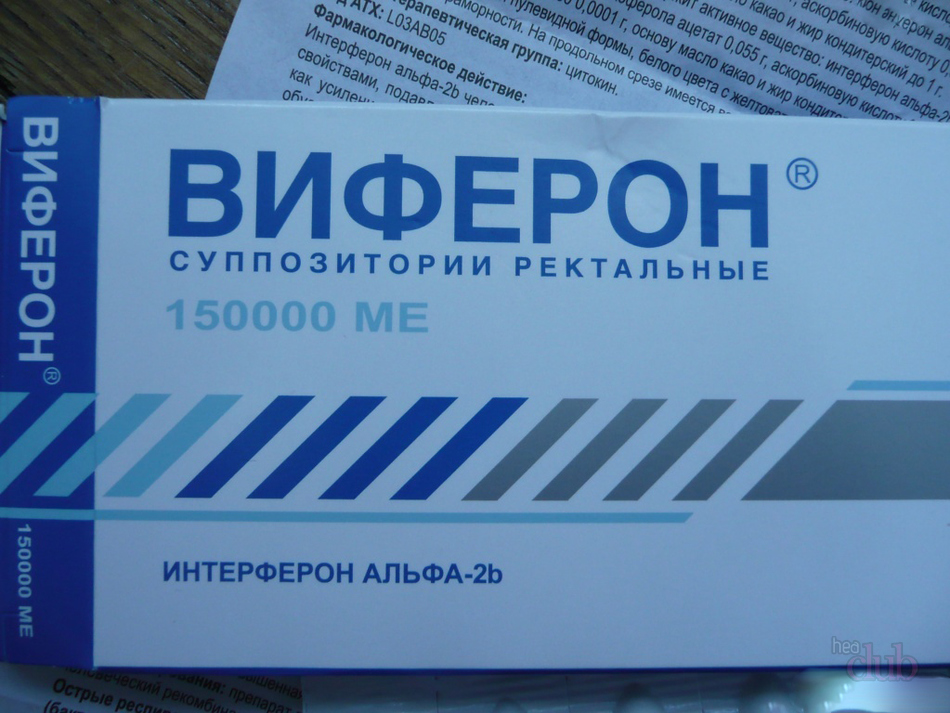 Both drugs contain the same active ingredient. But, unlike Interferon, the composition includes vitamins and other useful compounds. In addition, "Viferon" in the form of suppositories is easier and more convenient to use for the treatment of a child. It is more convenient to store "Viferon". A solution of "Interferon" can not be stored for more than 12 hours.
Both drugs contain the same active ingredient. But, unlike Interferon, the composition includes vitamins and other useful compounds. In addition, "Viferon" in the form of suppositories is easier and more convenient to use for the treatment of a child. It is more convenient to store "Viferon". A solution of "Interferon" can not be stored for more than 12 hours.
"Alfaferon"
"Gripferon"- an immunomodulatory drug (drops and spray) with antiviral action based on interferon alfa. It is used to prevent and treat viral infections.
Wellferon- solution for injections based on the active substance interferon alfa. Used to fight viral infections.
"Inferon" — medicine made on the basis of interferon alpha, which has an antiviral effect. It is used for the prevention and treatment of acute respiratory viral infections, influenza and other diseases.
"Lokferon"- a drug made on the basis of interferon alpha with an antiviral effect. Produced in the form of a lyophilisate for the preparation of a solution.
 Oleg. A good tool. I noticed that if you start using it in time at the first signs of the disease, you can quickly put yourself on your feet. The last two times it was restored in 2-3 days. I advise everyone.
Oleg. A good tool. I noticed that if you start using it in time at the first signs of the disease, you can quickly put yourself on your feet. The last two times it was restored in 2-3 days. I advise everyone.
Ilona. Immunomodulators are certainly good, but I would not recommend using them often. Our body is “lazy” and if it sees that someone is working for it, it immediately begins to hack. This also applies to the immune system. Therefore, you need to weigh the pros and cons when taking this medicine. Yes, during a flu epidemic it is still better to use Interferon. But, in all other cases, the body must fight itself.